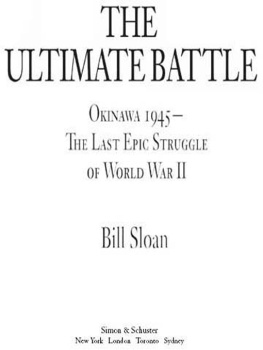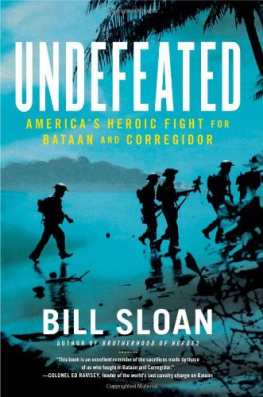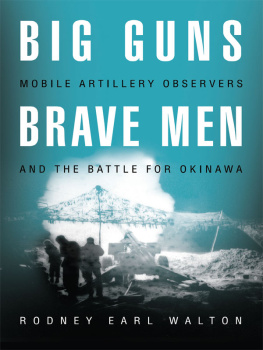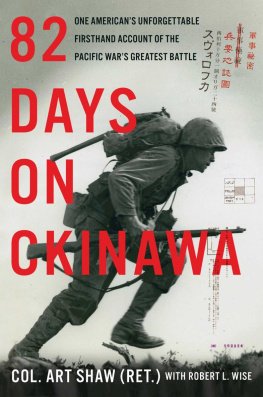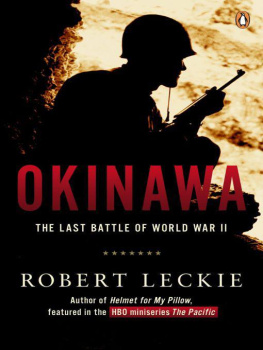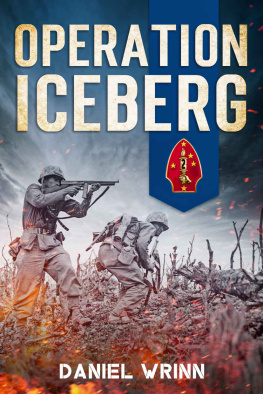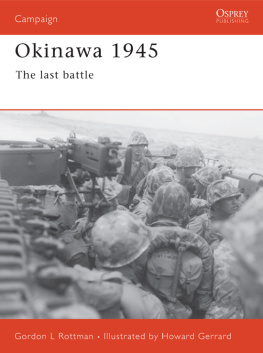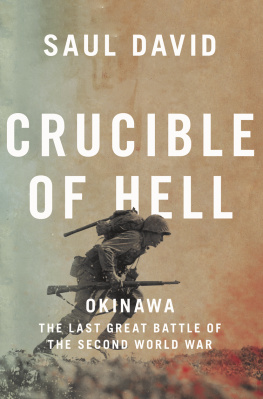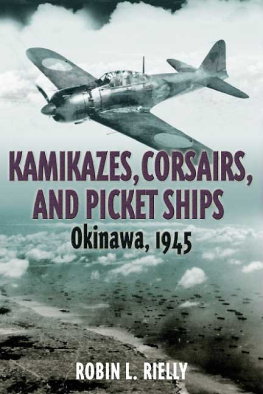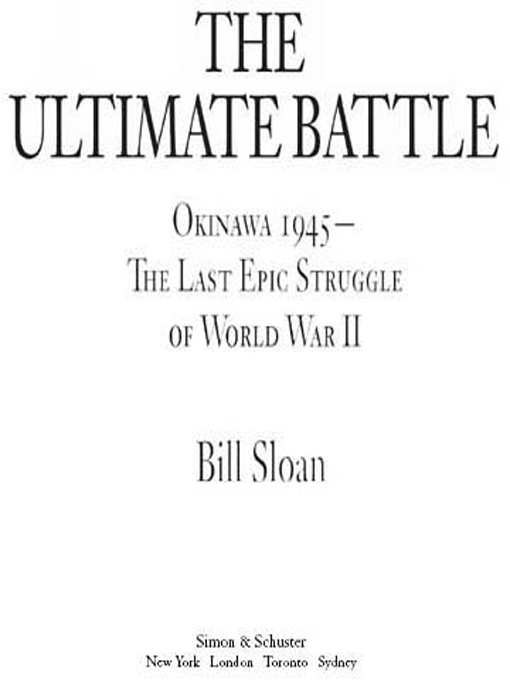Elvis, Hank, and Me: Making Musical History on the Louisiana Hayride (with Horace Logan)
All rights reserved, including the right to reproduce this book or portions thereof in any form whatsoever. For information address Simon & Schuster Subsidiary Rights Department, 1230 Avenue of the Americas, New York, NY 10020
SIMON & SCHUSTER and colophon are registered trademarks of Simon & Schuster, Inc.
Maps by Paul J. Pugliese
Sloan, Bill, date.
The ultimate battle: Okinawa 1945the last epic struggle of World War II / Bill Sloan.
p. cm.
Includes bibliographical references and index.
1. World War, 19391945CampaignsJapanOkinawa Island. 2. Civilian war casualtiesJapanOkinawa Island. 3. Okinawa Island (Japan)History, Military. I. Title.
To the memory of PFC Alfred E. Al Henderson, my late father-in-law, who fought at Okinawa with the 96th Recon Troop of the 96th Deadeye Division. After the war, like many other veterans who survived the battle, he never talked about what happened to him there. Now I can understand why.
Prologue
Kunishi Ridge
Southern Okinawa
June 10, 1945
T ANK COMMANDER Jack H. Armstrong was bleeding from both ears, addled by a concussion, and deafened by the shell that had just ripped a jagged eight-inch hole through the center of his Sherman tank, missing Armstrong by a foot or two at best.
The M4A1 Sherman was one of three tanks that had moved out ahead of infantry units of the First Marine Division this morning to scout enemy-infested Kunishi Ridge, the last remaining Japanese stronghold near the southern tip of Okinawa. When theyd come under intense artillery fire, the other two tanks managed to beat a hasty retreat, but Armstrong and his crew, grinding along in the lead, werent so fortunate.
In the soundless void whirling around him, acting Sergeant Armstrong wondered if he was seriously wounded, maybe dying. Death was a constant companion these days for men of the First Marine Tank Battalion, and the expectation of being killed or maimed at any moment was as much a part of life as breathing. But now death felt especially close and intimate, and, as Armstrong squinted through the tanks smoldering innards at the young second lieutenant sprawled a few feet from him, he understood why.
The lieutenant, whod come along on their mission strictly as an observer, was still writhing in agony, but it was obvious that hed be dead soon. His belly was split wide open, and his intestines spilled out into his lap. His left forearm hung by a thin strand of mangled flesh. This was the lieutenants first combat mission. It would also be his last.
The lieutenants mouth moved, and Armstrong read the plea on his bloody lips without hearing them:
Oh God, Mama, help me.
Armstrong turned to see Corporal Stephen Smith, the tanks driver, crawling toward him. As tank commander, it was Armstrongs responsibility to take charge of the situation.
He nodded toward the lieutenant. I hate to move him, but lets try to get him outside, he told Smith, feeling the words vibrate in his throat. If we take another hit, were all dead.
Armstrong watched as the lieutenant pulled out his Ka-Bar knife and severed the thread of tissue that bound his ruined left arm to his body. When the arm fell away, its former owner dropped the knife and looked at Armstrong. That might make it a little easier, he whispered.
With Armstrong attempting to hold the lieutenants exposed organs in place, he and Smith half carried and half dragged him down through the escape hatch in the floor of the tank. Behind them, Private David Spoerke, the designated loader for the 75-millimeter cannon, moved to aid the Shermans bow gunner and assistant driver, PFC Ben Okum, who was moaning and bleeding from wounds in his arm and leg.
It took what seemed like an hour for the five of them to make it to a nearby shell crater that was barely far enough away to keep them from being blown up with the disabled tank if it should explode. By the time they laid the lieutenant in the deepest part of the hole, his eyes were glazed and his face was grayish.
Give me some morphine, and get out of here, he whispered. They may open up on us again any second.
Armstrongs hearing was beginning to come back, and the lieutenants words were faintly audible. We cant leave you here like this, Armstrong said. Well try to get you a medic.
Just go, Jack, the lieutenant said. Dont waste your time.
Smith broke open one of the needle-equipped morphine packets that each Marine routinely carried and injected the dying man in the neck. Armstrong put some extra packets beside the lieutenants right hand, and Spoerke tried to tie a belt around the stump of his left arm to slow the bleeding.
Get moving, the lieutenant said. Thats an order.
The lieutenant was a new replacement whod just joined the battalion as a platoon leader, and hed been around only for a day or two. Armstrong couldnt even remember his name, but he seemed like a decent enough guy. He was a friendly, easygoing sort who got along well with the tank crews. He was also a helluva lot tougher than he looked.
Any man who can cut off his own arm with a Ka-Bar has to be one gritty SOB, Armstrong thought, even if hes too deep in shock to know what hes doing.
Aye, sir, Armstrong said. Well send help back as soon as we can.
In his dazed condition, Armstrong almost forgot that he was under strict orders to destroy the gyrostabilizer unit on the tanks 75-millimeter gun to keep it from falling into enemy hands, so he had to stagger over to the Sherman, drop a grenade into the unit, and scramble back to safety.
Back at the crater, he took a last look at the lieutenant, who was silent and ashen but still appeared to be breathing. Then he bit his lip and turned to help Smith with the wounded gunner. As they stumbled back along the draw theyd come down a few minutes earlier, a burst of fire from Japanese rifles and automatic weapons kicked up dust inches from their heels. Armstrong took one brief glance over his shoulder at a hillside literally crawling with Japanese, each of them firing at the fleeing tankers. Then he ran for all he was worth, pulling Okum along by his good arm and thinking: Those guys must be the worst shots in the Japanese army! How can all of them possibly be missing us?
This was the third tank that had been blown out from under Armstrong in just over a monththe first by a volley of armor-piercing shells from a Japanese antitank gun, the second by a land mine. Four or five guysboth tank crewmen and members of the infantry fire team accompanying the tankhad been wounded in the blast from the land mine, at least two fatally, and Armstrong had lost a damned good driver to the antitank gun. But this third time seemed worse than the others. The image of the lieutenant lying in the shell hole haunted Armstrong, and he couldnt block it out of his mind.

